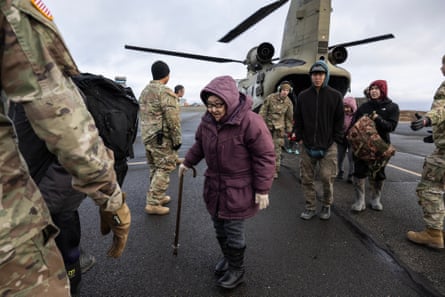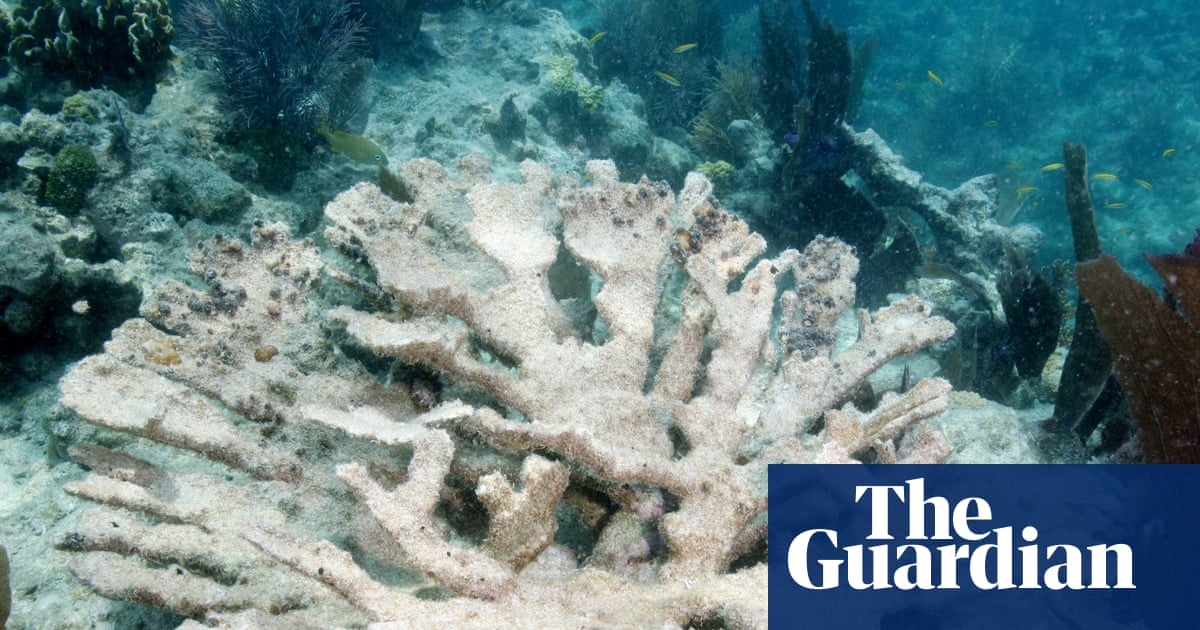A faltering federal response to one of the worst storms in Alaska’s history, which caused hundreds of people to become homeless, is drawing further scrutiny over the Trump administration’s efforts to dismantle federal weather and climate protections.
The powerful remnants of Typhoon Halong hit remote communities in the Yukon-Kuskokwim delta of south-west Alaska on 12 October, inundating a vast low-lying area of tundra that is home to some of the most remote and inaccessible communities in the country.
Flooding caused catastrophic damage and forced a large-scale exodus of much of the region, with survivors recounting having only a few hours to pack up their belongings into a single bag to board rescue helicopters – even having to leave pets and cherished family heirlooms behind.
The Alaska national guard airlifted more than 1,500 people to Anchorage on military cargo planes, comprising an evacuation of a sizeable percentage of the approximately 20,000 total Yup’ik Alaska Native people who live in the region.
On Monday, Alaska’s governor, Mike Dunleavy, said it could be more than 18 months before survivors could return to their homes due to the severity of the damage. Trump authorized a federal disaster declaration – which frees up crucial federal assistance – on Thursday, nearly a week after being requested by Dunleavy.
“This is directly keeping funding out of the hands of disaster survivors who need it,” wrote emergency management expert Samantha Montano in a post on social media, also calling the delay “absolutely insane”.
“This disaster is of a severity that the request would have normally been signed within a day of receiving a governor’s request. Not doing so is a deeply alarming departure from what Americans have come to expect from the federal government in times of disaster,” Montano said.

A presidential disaster declaration allows the Federal Emergency Management Agency to assist with state, local and tribal authorities in recovery. Trump has said he plans on “phasing out” Fema this year and turning disaster response over to states, a move that experts have said would make the country less prepared as the climate crisis worsens storms.
In the meantime, hundreds of storm survivors took shelter in an Anchorage sports arena and convention center while city officials worked to identify available hotel rooms and rental properties. The city has taken the rare step of declaring its own civil emergency – despite the storm itself having struck 500 miles to the west.
In addition to the delayed federal response, a majority of western Alaska’s weather balloon network was not operating during the landfall of the storm last weekend due to staffing constraints inflicted by the Trump administration, current and former National Weather Service officials have confirmed to the Guardian.
The remnant circulation of Typhoon Halong was able to maintain considerable strength over near-record warm waters of the Bering Sea and packed winds exceeding 100mph in addition to record coastal flooding before taking a rare track from the tropical Pacific directly to Alaska.
Meteorologists said Trump’s cuts in weather balloons likely negatively affected the weather forecast, which had large errors in the day before landfall – complicating the warning process in advance of one of the most destructive storms in state history.
“It seems likely that that had some effect on the model performance,” wrote Rick Thoman, a former National Weather Service (NWS) meteorologist, in a post for the Conversation. “This one’s final track and intensity weren’t clear until the storm was within 36 hours of crossing into Alaska waters. That’s too late for evacuations in many places.”
after newsletter promotion
In an email to the Guardian, Thoman wrote that other more recent cuts by the Trump administration also likely aggravated the warning process for Halong.
“In many of the hard hit communities, the ability of folks to get updated forecasts is very limited due to frequently poor and intermittent connectivity [to the internet and public radio],” Thomas said. KYUK, a Native-owned public radio station in Bethel, the largest town in the Yukon-Kuskokwim delta, lost 70% of its funding last month when the Trump administration dissolved the Corporation for Public Broadcasting.
In April, the National Oceanic and Atmospheric Administration (Noaa), the parent organization of the NWS, instituted what it called “degraded operations” in response to staffing cuts made by Elon Musk’s so-called “department of government efficiency”. Among the steps was reducing the number of weather balloon launches in some of its most remote offices in the midwest and Alaska – limiting the amount of information meteorologists have to make warning decisions.
“We have been managing up here,” an Alaska-based federal meteorologist said. “We are understaffed, though. It seems like there is more on all our plates with the staffing shortages.” The meteorologist requested anonymity because they were not authorized to speak publicly.
In an emailed statement to the Guardian, Noaa spokesperson Kim Doster wrote: “The NWS Alaska region remains adequately staffed to meet its mission of protecting lives and property. Despite the difficulty of forecasting weather events across the northern Pacific and Bering Sea given the lack of data availability over the open ocean, the NWS models in this instance did identify the potential for a high impact event days in advance, allowing IDSS (Impact-Based Decision Support Services) to begin communicating with public officials and emergency responders as early as October 9th.”
The crisis has drawn attention to the region’s worsening vulnerability to rising sea levels due to the climate crisis, and to the Trump administration’s cuts to federal grants aimed at helping the region mitigate disaster risks.
In particular, a $20m Environmental Protection Agency grant was terminated by the Trump administration earlier this year that was intended in part to improve flood protection to the same communities hit by last week’s storm.

 3 hours ago
9
3 hours ago
9

















































